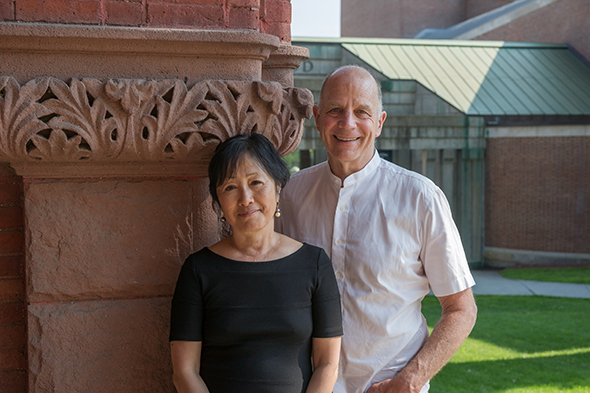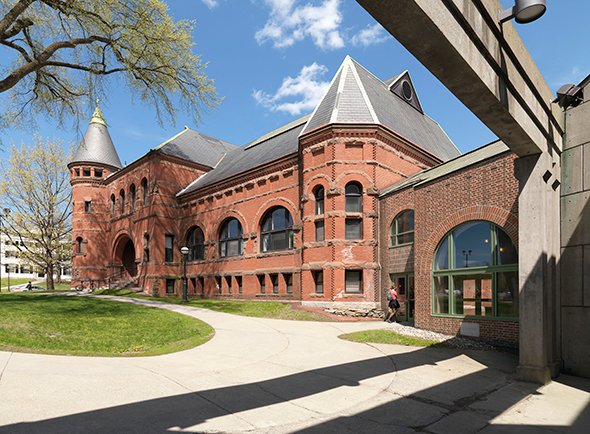
- About
- Departments & Services
- Projects
- Construction in Progress
- Service Requests
- News & Communications
Back to Top Nav
Back to Top Nav
Back to Top Nav
This story was originally published in the Autumn 2012 issue of the Hood Museum of Art “Quarterly.” The interview was conducted by Michael Taylor, director of the Hood Museum, who asked architects Tod Williams and Billie Tsien, of the New York firm Tod Williams Billie Tsien Architects, about their plans for the renovation and expansion of the Hood.
Michael Taylor: Tod and Billie, what attracted you to this commission?
Tod Williams: You! (laughs) We heard wonderful things about you from Philadelphia and that something new was going to happen up at Dartmouth. We both went to Ivy League schools and are incredibly interested in art, so we had been to the Hood and seen its treasures and its amazing location.
Billie Tsien: We’re also very interested in the idea of a teaching museum. We go to a lot of museums, but this project addresses a new paradigm: it is a teaching museum, not a museum that teaches. That’s very different from anything we’ve ever done. Imagining what that might be is a really interesting challenge.

Billie Tsien and Tod Williams of Tod Williams Billie Tsien Architects have a longstanding engagement with the arts, from designing artist studios and exhibitions to completing a wide range of museum projects. (photo by Eli Burakian ’00)
Taylor: Speaking of challenges, what would you say is the biggest challenge that you face with this project?
Williams: Charles Moore, who was Billie’s thesis advisor, did very fine work that was just right in the 1980s, but we really need to bring a fresh face to this. It is crucial that we create a visible destination that is woven into the heart of the campus, as opposed to making it an attractive hidden gem.
Tsien: I think the really big issue is how do you unearth the hidden gem. Another question we are facing is how can the Hood be very clear about where its front door is located. With the new Black Family Visual Arts Center, we’re not only trying to address the Green, which is the traditional heart of the campus, but we’re now trying to address a whole arts quadrangle.
Williams: And this new arts quadrangle really may be the future center of the town of Hanover itself. We see the Arts Plaza as a place around which Hanover will grow and develop. Dartmouth has always been invested in the arts, but now we see that it’s really flourishing.
Taylor: We are transforming the traditional idea of a museum to include a Museum Learning Center, focusing on supporting object-based learning for Dartmouth students in state-of-the-art museum classrooms, which will be something that any teaching museum around the world will need in the future. There isn’t a single department at Dartmouth that wouldn’t benefit from learning with the collection at the Hood. For example, our relationship with the Geisel School of Medicine shows us that doctors can improve their visual diagnostic skills through the study of objects in the museum.
Williams: What’s interesting to us in your vision is that any student on the Dartmouth campus, anyone studying any subject, could apply their study at the Hood.
Taylor: Absolutely. Can you talk a little bit about how landscaping will be used to connect us to other buildings around the Green?
Williams: The Green was the town center and meeting place in New England, so the ground plane is very important to every campus, every community, every town. At the same time, you have a unique condition in that we’re now building closer together and we have a more dense and diverse population. The Hood expansion project is a unique opportunity to make visible connections through the use of a beautiful landscape that runs its way right through town and that establishes itself in the vistas and hills all around us.
Taylor: What are your thoughts on Wilson Hall?
Tsien: After walking through Wilson Hall, I just can’t wait to clean out everything and take a look at the bones. There are some incredibly beautiful and very powerful spaces in Wilson Hall, and stripping it down will help us to see, for example, the height of the top floor and the skylight. People are really just going to be blown away.
Williams: I think we’ve always seen Wilson as being a solid citizen on the campus but we might not recognize it as one of the real gems. We want to release it to its original grandeur—the turrets themselves are amazing spaces.
Taylor: What I loved about your proposal is that it is really about bringing back the dignity of Wilson Hall.
Williams: We aim to restore its identity not only as a building with a remarkable exterior, but one where the interior is profoundly connected to its exterior.

The project will include the renovation of Wilson Hall. “We want to release it to its original grandeur—the turrets themselves are amazing spaces,” says Tod Williams. (photo © Bruce M. White, 2012)
Taylor: You are highly regarded for your work at the Phoenix Museum of Art, and you’re just coming off of your work with the Barnes Foundation. Do you feel like the more museum projects you work on, the better you are at thinking about spaces for art, or do you think that you’ve always had a feel for that?
Williams: I think we are continuing to learn. What we’re seeing with the Hood is that there are so many different ways by which we can envision the art experience.
Tsien: I think because art is something that we love in our own lives, museum projects excite us. Art and museums are a thread to some of the work we’re doing, and each time we’re learning something new. I don’t think we ever actually have the answers because we’re always looking.
Williams: One can be trained to be an artist, one can be trained to be a historian, but every child, every person, intuitively, has an instinctual sense of art. Art will continue to be the part of our lives that most quickly changes, and it does seem to me that the way art changes reflects the ways that art versus society changes. We need to be ready for change. This is a really dynamic moment because we’re beginning to recognize that the arts are key to our growth as a society.
Taylor: That’s a wonderful way to end. Thank you both.